Last week we travelled down to rural Sussex to interview collage artist Joe Webb in his new studio about his up coming solo show 'Pulp Friction' - 8 June - 21 July at Hang-Up Gallery.
It's an insightful interview from gallery manager, Carla Nizzola looking at Joe's work and practice which can be seen in part below and the full interview is also on the Hang-Up blog
Your new show 'Pulp Friction' will display a varied collection of works ranging from your first original collages to your recent abstract works and larger scale paintings. Why did you want to display such a varied collection as opposed to one particular body of work?
It was just a way of showing a transition of where I started with the more surreal, quirky scenarios in the early works and the way I've progressed with the more silhouette-base, dreamlike images in the last year or so - and I've got newer collages now which are even more minimal. I think it's important to keep evolving and changing rather than doing the same thing, but to still have a recognizable look throughout.
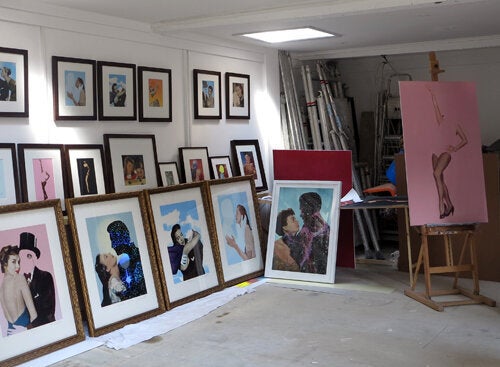
You can definitely see a progression. Your more recent collages are a lot more simplistic and clean as opposed to your early works. Was this intentional?
I'm not sure it was intentional. It gets to a point where you've made so many of them that it comes repetitive rather than exploring a new ideal. It's a natural evolution of a way of working. I try to keep the idea throughout of using minimal materials. It's just a couple of pictures - two different pictures put together...maybe in a year I'll have a really elaborate picture with lots of images...
That leads me to my next question: You have a 'self-made rule', which is working with only two images. You have stuck to this throughout your practice. Can you expand on that?
It was a starting point. When there's no boundaries or nothing to focus on there's nowhere to go with it. It's like having a brief for a piece of work or graphic design. You can then come up with a finished product. I found that as soon as I did this it became a challenge to marry two things.
How do you choose the two images?
I have loads and loads of magazines. If I see something that I think will work I put it aside and then five months later I might see something else and try and put them together. It's quite a lucky, random process. Sometimes I'll spend five hours sifting through and nothing matches. I'll leave it and go to something else. You've just got to keep working on it.
So the stories come to you whilst you are sifting through? Or do you tend to have an idea for the subject matter and composition before you create an image?
There are themes, like marrying the space and universe images with the fifties kids and family based images. The idea of the innocence of them and the vastness of space worked well. I tend to focus on the fifties era because there's a constant dreamlike look throughout which ties the collages together.
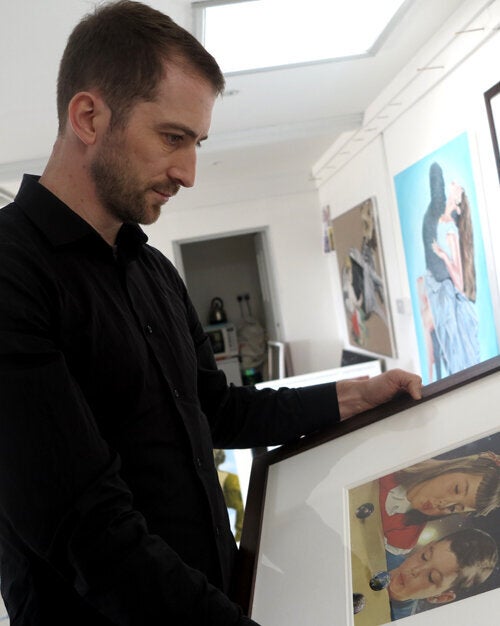
Why did your earlier works have more political/humorous connotations?
I thought it would be nice to have work that said something. I find when I visit galleries there's a lot of work you look at that doesn't say anything and you think, 'Am I being duped into believing I'm not intelligent enough to understand this?' I was frustrated with that artwork and I wanted artwork to say something.
I want people to get a story from it, like my collage of the tribal African guy in a mask dancing on a table in a meeting. These things are going on in different sides of the planet and putting them together takes on a whole new meaning - it kind of mocks the meeting and the serious way we take ourselves.
The original idea stemmed from Sir Peter Blake's collages, from the Bandaid album cover with the African kids in a Victorian house. That idea stuck with me. You can make a statement on how different things are for different people depending on where they are from. When they are put together it is powerful. It was a way of looking back at the world and examining different cultures. You can go anywhere with it.
Why did you want to name the show Pulp Friction?
The pulp is the paper that I work with and 'Pulp Fiction' is the era of the fifties where a lot of the images are from. The friction is the characters. There's a tension between some of them, like the guy with the monocle in 'Mono' is disappearing out if the frame. So it ties in nicely with the work.
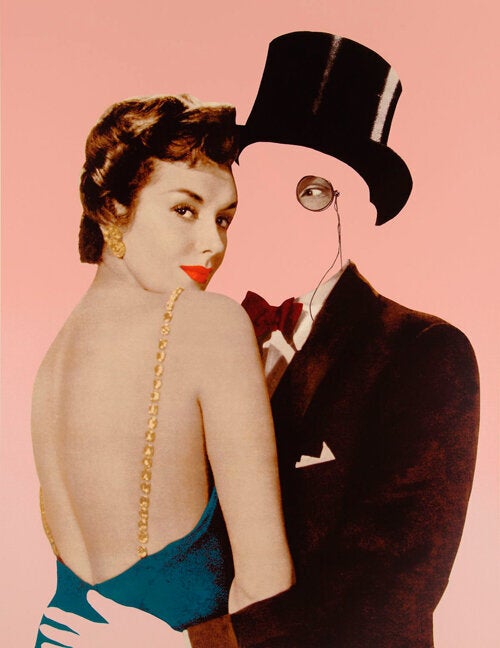
Above: Joe Webb, 'Mono', 2012, silkscreen print on paper with diamond dust, embossing and gloss glaze.
What started the initial infatuation with the 1950s romantic/murder mystery era?
It's iconic to start with - the images have that quality and open your eyes up.
Have you been creative all though your life? How long have you been making work for and what was the initial inspiration? Have you always worked with collage?
I was always drawing as a kid, and went to Art College as it was my interest and that's where the painting aspects came in. It was my foundation and it was a really good college and I had a few really good painting tutors - I really enjoyed it. Then I went onto my BA, and it was completely different. It was more conceptual and I couldn't' relate to it. I still got a lot from it but it put me off art for a few years so I moved away from making art and got more into graphic design to make a living. So I started using computers. Within the last 6 or 7 years I started painting again, then last 3 years moved into collage and found it really works and its been going since then.
Was there a particular moment when you started using collage after your years of painting?
It was a friend actually. James Chappell. He is a collage artist and I thought they looked really punchy. It's a quick way of working and it was something different to try. Also, Sir Peter Blake's collages - they're so graphic and painting can either work or not. It was a new thing for me.

Now you work as a free-lance graphic designer, which means a lot of work with computers. Is your hand-made art practice an act of rebellion?
I was getting really fed up with using a computer. Our whole lives are becoming based on computers now. I wanted to get away from that so in the evenings I could make some art. I wanted it to be something hand-made. So that was one of the first rules; working with that limitation. If I was to use Photoshop they would have looked completely different becuase I would have changed the colour, scale - it would be too polished and wouldn't be as interesting. The small faults are all part of the hand-made charm. They are almost old artworks already. Even though they have just been made there is still a history behind them. If they were just a print out they wouldn't have the same effect.
I do feel bad cutting up a nice magazine that's there's not many left of...but its better to make an artwork out of it for someone to put on their wall than just have them sitting there I guess?
Where do you find the vintage books and magazines? Are they vintage/charity shops? Worldwide?
When I'm in a new area I'll try and find a shop I haven't been in and there's usually something I can get. There are a few fifties-type places that I know that I go to a lot. I don't really like shopping so I don't like wandering around.
I just rescued these (shows me a folder of Seventies magazine cut outs) from a recycling bin from an illustrator friend. They're like a Google before Google...someone's made folders of the past. These are more Seventies so they night take me somewhere else...
Are they always vintage/second hand?
Yes, mostly. I tried modern magazines but they're too glossy and you get into the whole copyright aspect. It's whether or not you can say something current with an old image and for it to not just be some super commercial, retro thing you see everywhere.
What do you do with them when you've finished? Do you keep them?
My whole house if full of these magazines now and it's getting a bit messy!
Many of your limited edition prints include various reliefs and textures such as diamond dust and the process seems very complex. Is this why you use Coriander Studio/CCA Galleries to publish your prints? Have you always used them to print your works or was this something you learnt through experience?
I was a fan of their work - the Sir Peter Blake prints and Damien Hirst prints they produce, and they were recommended. They make top quality, collectable prints. I saw them when I went to London Print Fair last year and they really stood out to me. I kept hassling them until they looked at my work and invited me up. I bought all my collages up, including the traditional silkscreen print 'Kissing Magritte' that I made myself. I managed to get that into the Saatchi Gallery to display in their new print shop and that sold really well so that gave me confidence to approach them. Luckily they really liked the prints and made four new ones, printing them at high quality with 30 colours, embossed and cut outs to make them like the collages.
It's nice to push forward with different techniques of silk screening. Each print has a different technique applied to it. It can make them a lot of money but at the same time, if you want to buy a painting you have to spend thousands. Prints are a good way of people getting a piece of artwork for under a grand, and they all retain their own value.
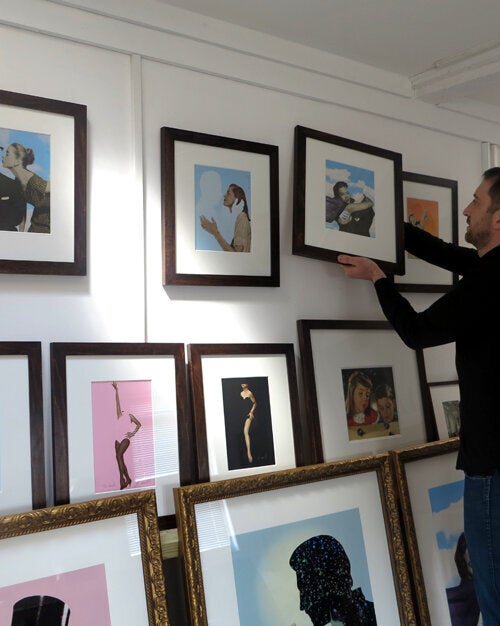
Do you work together?
It's a bit of both. We'll talk about the work and what I want to get across. With 'Absent Minded' we decided to cut out the guy almost like someone's lifted out the picture. We try out different processes. In 'Daydream' its embossed, which gave the look of the sky like a lens, which distorted the image and reveals the shape of the guy's head. With the 'Antares' pieces I'd seen some prints of some stars on holographic paper so we used that.
Why have you chosen to go back to painting in your most recent work?
I don't want to be defeated by painting. I've been trying to paint for years and always found it quite difficult. Not knowing what to paint has been the biggest issue and has stopped be from working for years. Now I have the collages that have given me my subject matter I want to revisit painting. I set myself a goal of taking this painting studio, working through he collages of the past and getting an idea of which ones work and which don't. I'm kind of playing catch up with my ideas.
Do you think the painting say something different to the collages?
They use different material, like blackboard paint and chalk, so it adds a different element. So it's more tactile and maybe a bit more accessible? It's just a different way of presenting them really. I don't want to give up on painting but I don't want it to detract from making collages.
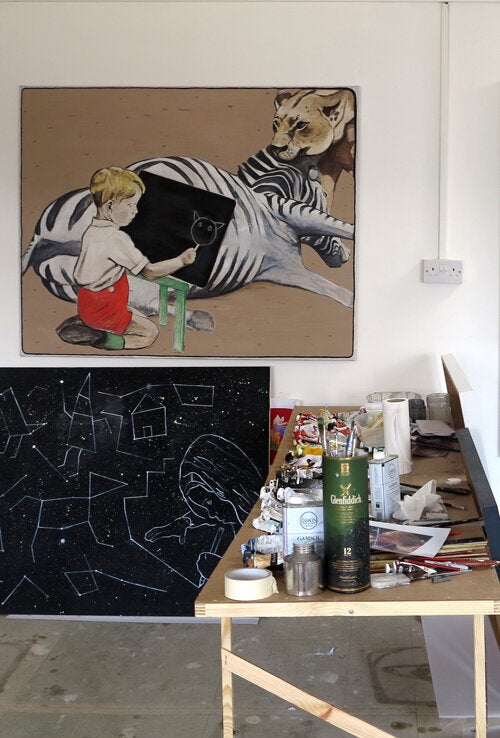
Above: Joe works on an oil painting inspired by one of his earlier collages.
The way in which you work is an incredibly long and intricate process, requiring a lot of time and patience. Are you meticulous in your personal life?
No, not really. I do get compulsive about my work. The artwork is something I can focus on and spend a lot of time on because I enjoy doing it...you can escape into it. Instead of watching TV for hours on end I can sit down and do this.
Are you a messy worker?
Yes - I'll start with one image and before I know the magazines are everywhere and I have this one tiny image and the whole room is destroyed. It's a bit of a nightmare. I try and treat paintings a bit differently. I pre-mix all the colours and find a way to translate it.
Is there a particular time of day you prefer to work or are your creations spontaneous?
I still work as graphic designer in the day, so it depends. If I have a quiet spell I can make collages and if it's really quiet I can start painting. Even if I don't feel like making art, when I have time I have to do it. You can be waiting for inspiration, and sometimes you have to just do it. Treat it like a 9-5 thing.
Do you listen to music whilst working?
Yes usually - sometimes it's the radio just to have some background ambience. And I've got tinnitus so my ear is constantly ringing, so anything would do. I listen to a lot of different stuff. I like historical stuff like blues or jazz.
Who/what are your main influences?
Rene Magritte a major influence. I went to Magritte's museum in Brussels and was blown away by the paintings. They're so graphic and so striking. The images just leap out. The surreal aspect of this lead onto my work from two years ago.
Then Peter Blake from the collages aspect. There's a lot of collage artwork out there but its all complicated.
And you're also influenced by Mattise?
Yes - his blue nude cut outs. I like associating work with an artist and developing from that. There's a lot of substance in doing that.
I also really like Peter Doig's paintings. Seeing his work ten years ago made me want to start painting again. I saw them at the Saatchi Gallery when it was on Southbank and thought 'This is what I want to do'. I went home and painted a house!
Do you have a favourite piece of yours?
I quite like 'Daydream'. And the 'Kissing Magritte' print - even though its very commercial I like it because it ties up everything: the vintage look, the Magritte influence, Surrealism - it's got quite a visible story to it and is easily read. It comes and goes though. I always like the latest thing I've made.
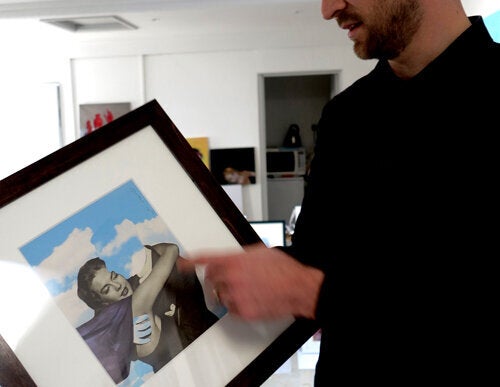
Above: Joe with one of his favourite pieces, the original 'Daydream' collage.
Why did you want to display at Hang-Up Gallery for your first show?
Hang-Up is going to be great because it's such a nice space. It's a nice size for the scale of the collages and it's intimate. It's going to allow people to look up close. In a bigger gallery they'll get swallowed up. As soon as I saw the new gallery online I thought I looked like a great space.
I had my work in another gallery and it was quite conceptual and I didn't feel at home there. Galleries that lead more towards the urban side of art fit my work better, as they're more approachable. I mean, I don't think my work is urban - I'm in a field so its actually rural! I want to feel comfortable in a gallery. Hang-Up is a brilliant next step.
Do you hang your work in your home?
I've got a couple in the house just really for storage. I've got other artists on the walls - a few prints and paintings. To have them up all the time would be a bit much. It's nice to keep it separate.
You were one of the two winners' of Saatchi's 'Showdown' competition last year and as a result had the piece displayed in their London gallery.
It was a collage showdown. I entered 'Antares and Love II'. I knew to put that one in as I put it on a blog and it went viral - there were 50, 000 shares all around the world. I put others online but they didn't do as well. As much as I didn't want to be involved on line it seems quite ironic, but it's a good way of benchmarking how things are being perceived. So I entered it and it got through the public vote, then judge vote which included Rebecca Wilson, the director of Saatchi - then the artist judge. Then it went up into Saatchi!
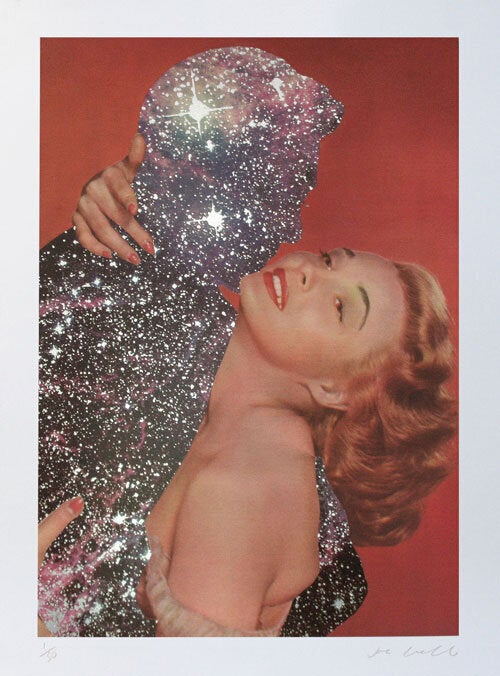
Above: 'Antares and Love II', silkscreen on paper with silver leaf and varnishes
That must have been a defining moment as an artist for you. Have you had a lot of interest in your work since then?
It was great - unbelievable. It's a brilliant platform. From that moment things have taken off. It's amazing really. I've made prints from the original. I also had my contact Rebecca from Showdown so I showed her the 'Magritte' print, then those went up in the print shop and did really well, so the momentum continued. The new 'Daydream' print is going to go up in the Saatchi store next month so its nice to continue the relationship with them.
If you could own any piece of artwork, what would it be?
I'd love a big Peter Doig painting - the one at the Tate Britain - it's just massive. When you look up close it's such a mess, but you stand back and it all makes sense.
If you could live anywhere in the world, where would it be?
I can see myself immigrating to a warmer country at some point- just to get better light...but I feel I might be stuck here for a while.
What lies next? Are you going to continue painting?
I wanted to spend the next few months making paintings and new collages, building a collection and hiring a pop-up space - something quite big. Really try and push myself forward. It's something that will take time.
Finally, why do you want people to come away with after viewing Pulp Friction?
I want them to have enjoyed the show and take away the key ideas behind the images. I'd like them to come away being entertained by the humorous images and slight mockery...and perhaps a print under their arm!
Interview from Carla Nizzola, Gallery Manager at Hang-Up Gallery
56 Stoke Newington High Street
London
N16 7PB
